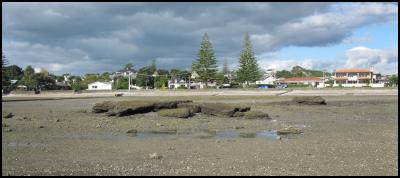Clues to Auckland’s past uncovered at Buckland’s Beach

Click for big version.
Clues to Auckland’s past uncovered at Buckland’s Beach
“A small intertidal reef at the north end of Bucklands Beach, Pakuranga, holds important clues to what Auckland was like 5000 years ago,” says Auckland marine geologist Bruce Hayward of Geomarine Research. Together with local marine biologist Margaret Morley they have identified fossil shells in the rock as those that lived below low tide in the strong current-swept entrance of the Tamaki Estuary. They recently presented their results at the New Zealand Geoscience Society Conference in Hamilton.
A fossil dog-cockle, still in life position, has been radiocarbon dated at Waikato University at 5000 years old. “It tells us that sea level was at least 1.5 m higher then than it is today,” said Dr Hayward. “The flat land behind Bucklands Beach now covered in houses and shops built up at the back of the beach at that time.”
“The Bucklands Beach reef rock is largely composed of shells and basalt pebbles eroded from Browns Island. These would have been swept into the Tamaki Estuary by strong northerly storms and tides. Today, volcanic rock from Browns Island is not washing into the Tamaki, but 5000 years ago there was no Rangitoto as it did not erupt in the middle of the harbour until 600 years ago. With no Rangitoto present, the eastern bays from Mission Bay to Musick Pt would have been far more exposed and it may have been possible to surf at these beaches during big storms,” speculates Hayward.
“The north side of Browns Island was much more exposed prior to eruption of Rangitoto. Its soft volcanic ash cliffs eroded back rapidly at a rate of 1 m every 20 years and some of this eroded volcanic sand and pebbles ended up on the coast at St Heliers, Bucklands and Eastern beaches. The sandstone cliffs from Orakei to Eastern Beach would also have been eroding much faster prior to Rangitoto’s appearance. Today erosion has largely stopped where the Tamaki Drive has been built around their foot. Elsewhere, such as at Archilles and Musick points, erosion has slowed with these steep cliffs now partly stabilised by vegetation growth.”
“The intertidal reef at Bucklands Beach has been cemented together by the growth of cream crystals of a mineral called motukoreaite, described on Browns Island some 25 years ago by Auckland University scientists. This mineral is now recognised in marine deposits of volcanic sediment all around the world.”
ENDS


 Antarctic Heritage Trust: NZ-made ‘Cutting-Edge’ VR Experience Tours The UK
Antarctic Heritage Trust: NZ-made ‘Cutting-Edge’ VR Experience Tours The UK Brian Gaynor Business Journalism Initiative: Brian Gaynor Initiative Business Journalism Funding Award Moves To Rolling Applications
Brian Gaynor Business Journalism Initiative: Brian Gaynor Initiative Business Journalism Funding Award Moves To Rolling Applications  Inland Revenue: Fifth Anniversary Of The SBC Loans - Time To Repay
Inland Revenue: Fifth Anniversary Of The SBC Loans - Time To Repay Te Runanga o Ngati Hinemanu: First Marae Based Fresh Water Testing Science Lab Grand Opening 16-17 May 2025
Te Runanga o Ngati Hinemanu: First Marae Based Fresh Water Testing Science Lab Grand Opening 16-17 May 2025 Raise Communications: NZ Careers Expo Kicks Off National Tour Amid Record Unemployment
Raise Communications: NZ Careers Expo Kicks Off National Tour Amid Record Unemployment Hugh Grant: How To Build Confidence In The Data You Collect
Hugh Grant: How To Build Confidence In The Data You Collect